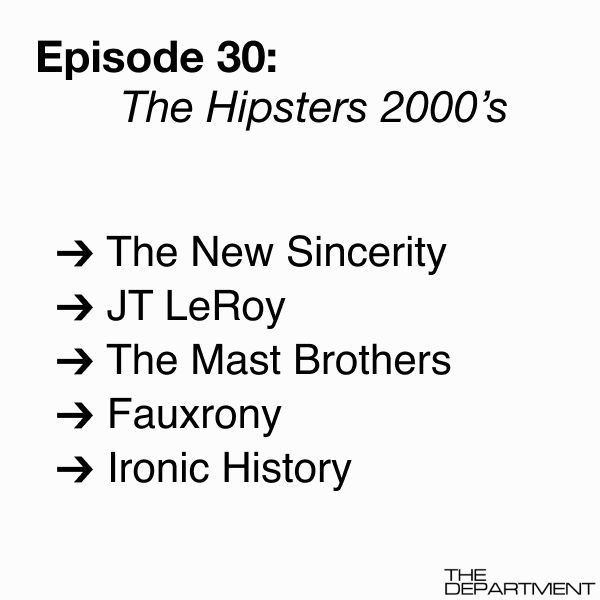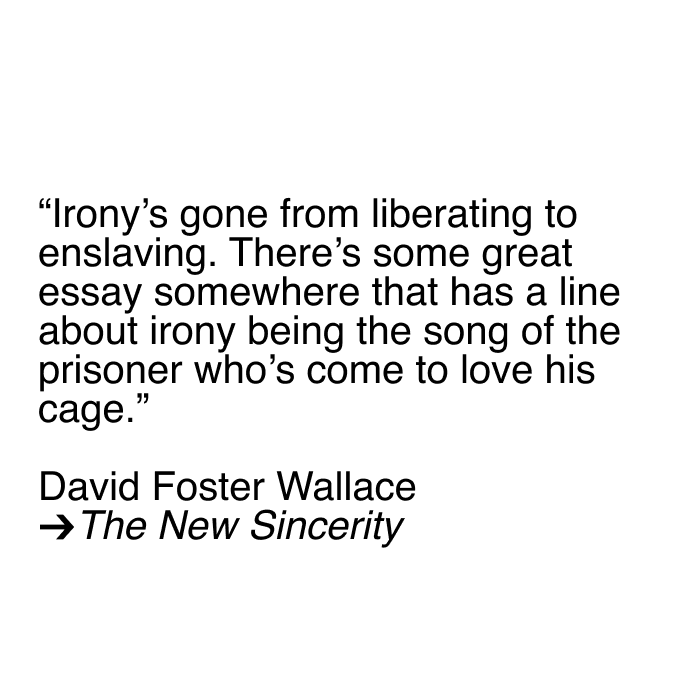︎︎︎episode 30
2000’s Trends: Hipster Scams of JT Leroy & Mast Brothers, The New Sincerity, Fauxrony & Ironic History
Feb 23rd, 2021
︎︎︎︎ Listen on Apple
︎︎︎︎ Listen of Spotify
︎︎︎︎ Listen on Stitcher

This week we continue a bit more into some 2000’s trends that not just defined that decade but offered some insight into our today. This week is a deeper look at IRONY (and misunderstandings) and some additional Scammers in the Hipster culture: JT LeRoy and The Mast Brothers.



The Juggling Act of JT LeRoy
Kim: So the first Scam for this week i am going to cover is that of the infamous JT LeRoy - Wunderkid and literary prodigy. The story is part performance piece, deception, literary masterpiece and hipsterati saga all rolled into one. It is such a legendary story and almost unbelievable - likely why we have seen a movie, two documentaries, a few books and countless journalism pieces. I have always thought it was fascinating and after watching one of the documentaries and seeing how it all unfolded I am sorta obsessed.
Required reading (JT LeRoy’s first novel):

Sarah: A Novel
So, I highly recommend watching the documentary Author: The JT LeRoy Story streaming on Amazon Prime - there is another doc and there is a 2019 film starting K Stew if you could believe it as well. Arthur: The JT LeRoy story comes from the perspective of the writer - so it has an interesting insider perspective.
I want to step back before getting into the scam - to set the stage or tone if you will for the period. I was curious about the trends in the literature world and was overjoyed to discover something that is relevant to today!
So during this time there was a trend of new hip late 90’s early aughts literati coming around with fresh voices emerging like Zadie Smith’s White Teeth, Dave Eggers A Heartbreaking Work of a Staggering Genius, David Sedaris’ Me Talk Pretty One Day, Jonathan Franzen’s The Corrections - under a movement called The New Sincerity which is sometimes described as Post-postmodernism and was popularized in the 90’s by David Foster Wallace building some momentum into the Aughts. It was a trend that ranged from literature to music to poetry. - even a cultural movement. What is fascinating about The New Sincerity is that it wasn’t ironic - it chose to recognize that irony was problematic and embrace sincerity, honesty, and rawness in whatever form that was. Cat Power Arcade Fire, Joanna Neusom and Neutral Milk Hotel, for example, has been considered part of the New Sincerity according to some music critics to give some context - and so were those authors and books i just listed as the hot new things in literature. David Foster Wallace had some really revolutionary thoughts on how Postmodernism’s cynical, ironic, self-deprecating, self-conscious and meta nature was pervasive in nearly all pop-culture as well as marketing, which was poisoning our culture - Some of his most relevant quotes and commentaries on the New Sincerity came from the 1990’s - which was very ironic but lor have mercy just wait til the aughts when it was practically a religion and in nearly everything we consumed, appropriated, watched and believed in.







i would love to keep going on about The New Sincerity movement - and will in some future episodes - because this theory and shift away from the Aughts blatant misuse of irony as humor was not serving to actually entertain but just ended up depleting us emotionally and creating a toxic culture - with this shift away from Irony people were so exhausted some creators started to embrace The New Sincerity and it brought some post Aughts refreshing shows like The Office and Parks and Rec as well as a shift in many aspect of our culture that we see today.... But i digress….
JT LeRoy was in theory the embodiment of this New Sincerity style - pure, tragic deep and real - or so we thought. Additionally as we have talked out Celebrity in any form was celebrated - so there was also interest in scouring for some literary celebrity at the time offering up young voices to capture the zeitgeist and be the ‘voice of the generation’. JT LeRoy fit the bill in all his cool mystique.
He visually burst on the scene - in 2000 - after being a very shy writer in the 90s - suddenly making appearances and flanked by supporting celebs giving him tips and doing his readings calling him and talking to him for hours on the phone. He was beloved - until they realized the truth - That he didn’t exist and all was the fabrication of a woman named Laura Albert - with her sister-in-law disguised almost as a puppet of JT for real-life appearances.
I have read other journalism that appears (and rightly so) to be very wounded by the con - so there may be various tellings of this story that put Laura in a harsher light or are convinced that she developed this whole situation to gain a foothold in the industry hiding behind a lie. I am choosing to tell it from the information I pulled by watching this documentary.
Essentially Laura Albert had been abused as a child in the 70’s and neglected by her parents - being placed on several occasions at mental health facilities as a child - eventually becoming a ward of the state. She began to dissociate from reality and embodied different personas to help cope with her mental health and trauma through her teens and all the way through into adulthood. This lead her to create a teenage boy named Terminator when she was in her 30’s and proceeded to call a suicide crisis hotline in the 1990’s - she started to formulate this persona and felt comfort in using him as a vessel to communicate with a therapist who she ended up working with for years. He encouraged Terminator to start writing and there was some arguably incredible outpouring and beautiful writing that came from this avatar who was just starting to develop his own identity and history. Mind you - Laura had a creative writing degree so she was and is immensely talented. But she essentially hid behind JT - she felt that her weight made her ugly, self-concious and unacceptable by societies standards to be even considered as a popular literary talent and worried that people would judge her. She does get gastric bypass surgery eventually after JT gets famous.
This story kinda reminds me of how brands get built based on trends - looking at what the market is dictating and demanding - almost as if Laura didn’t think her personal brand would ever be able to scale to the level of popularity even though she is so talented so she created a person that the industry would just eat up. And she did! But just like with brands - there is an accountability to be authentic in the mission and values - and if you are not - which we have found with brands like Everlane - you are setting yourself up for a huge fall out.
She is a great writer as I mentioned but also very smart and persistent - and I suppose a bit manipulative. She used the phone and various connections like her therapist to locate and intrigue iconic writers for mentorship and guidance as JT. People gravitated to the “person” behind these stories which gave the writing an authenticity and sincerity - which, as I mentioned, was becoming a popular trend at this time - especially in the new voices.
Laura continued to fabricate a rather tragic backstory that JT or Jeremiah Terminator LeRoy was a transgender teen hustler whose mother pimped him out as a prostitute at truck stops throughout the South, until winding up on the streets of San Francisco in the nineties. At some points the story she wound had him HIV positive - and usually he was a heroin addict a la Basketball Diaries to pull on those heartstrings a bit harder and curate this really touching dose of humanity and struggle. He was conveniently extremely shy - yet oftentimes outgoing and charismatic on the phone some pointed out and getting more so as he became more famous - Conducting conversation and interviews on the phone Albert spoke in her character’s Southern drawl while preferring to conduct most of his business over email and fax all the way through the 90s.
In 2000 his harrowing story preceded him and the allegedly autobiographical yet fiction designated book “Sarah” was released to critical acclaim and great celebrity fanfare. The documentary was so incredible because Laura apparently taped most of the conversations she had on the phone. She conceived him as a recluse and celebrities would call and develop close relationships with him - Wynona Rider, Courtney Love, Lou Reed - a lot of the underground and cool celebrities supporting this new voice in literature and being moved by his story and fame. As JT wouldn't personally go to any of the readings - claiming suffering from crippling crowd anxiety - Writers, musicians and celebrities would read for him. Eventually the pressure was on to get a physical incarnation of this non-existant person and Laura’s husband who was also in on the hoax had a sister named Savannah who was pretty but also rather ambiguous with short hair. Laura paid her $50 to be JT at a reading - so clad in a blonde wig, sunglasses, on point southern accent and black brimmed hat JT became a reality. And alongside him was another alter ego starring Laura herself as a faux british accented “Speedy” - as JT’s manager.
They did start their own trend - in the book the raccoon penis is a sexual amulet used in the South parts of Appalachia. JT talks about this necklace often in Sarah so they started to sell these at the reddings and they sold so many of these damn things - in the documentary everyone is walking around wearing them. Even bookstores were selling them - there was a SF bookstore in the 2000’s who’s best selling item for weeks were these Racoon penis bones.
Laura as LeRoy went on to publish a book of short stories in 2001 that became The Heart Is Deceitful Above All Things which became a movie by Asia Argento in 2004. Which is sorta an ironic title….
In late 2005, successive investigative pieces in New York magazine and the New York Times revealed the truth. At this point JT was a huge literary celebrity. People were shocked and outraged - their trust tampered with and I think just really disappointed that this was all an act and a con -using a tortured profile of a person as a front for their own work - taking advantage of celebrities - loving the fame and fortune without being honest.
The trans community was also rightly furious that it shows insensitivity to gender issues and trans appropriation. Citing trends in mainstream media at the time like New York Times bestseller Middlesex and mainstream movies Transamerica, in which representations of trans experience are often not based on the experiences of any actual trans people.
Mast Murders
Kim: When you think of hipsters 2000s you might think of really fussy artisanal ye olde pretentiousness - and when you think of really fussy artisanal ye olde pretentiousness you likely think of the Mast Brother’s. Photo’s of the bearded duo, folded arms and stern expressions still haunt my memories.
I remember eating it - giving and getting it as gifts. I never thought it was extraordinary or never have I ever dreamt of eating a bar - needing to run out and get my fix (unlike Ritter’s cornflake bar which I have gone out to get specifically) - I had no palate for this type of chocolate - but we were told it was good. We ate up the product because it was positioned to hipsters in a way we loved to consume. Authentic. Premium. Special. A luxury, hand wrapped in idealized Brooklyn graphic-designed san serif font and eclectic wallpaper prints. We had to trust these bearded gentlemen to show us the way into the pure, quality chocolate land that went against the corporate construct. And we trusted they would deliver this to us so we could consume the superior product at a premium price smugly and consciously.
So let me take it back to the beginning - Mast Brother’s Chocolates grew out of the trend of the single-origin and artisanal food movement as well as the quintessential “Brooklyn Maker” story - Something that really started in Hipsterland aughts for many products complemented by two appropriately hipster brothers - including some Ye Olde style with extreme bearding.
Mast Brothers launched in 2007 and are considered to be the first “bean to bar” chocolate brand wrapped up in a fully trendy and hipster aesthetic hitting the trend so poignantly that the brand blew up. They were the originals, innovators, disruptors - the first of the kind which saw replicants based on their success. But, over the years there were some hints that something fishy was going on with the chocolate. Professional chefs and chocolate connoisseurs rated these luxury chocolates as some of the worst in class. With a pallet and nose to spot the flavor profiles of single-origin and hand-crafted chocolate - professionals claimed these bars had a flatness and un-complexity much like mass-manufactured types.
By 2015 - Despite all that they had expanded incredibly and the consumer loved their brand even if the product itself wasn’t considered incredible to a connaisseur - we believed it was premium because we were told it was. They had moved ahead with a grand expansion opening up a 6,000 square foot chocolate factory and shop in L.A.'s Downtown Arts District. Their opened a London facility and they had a new 65,000-square-foot facility in Brooklyn's Navy Yard.
In early 2015 there was an article in Slate by Meagan Giller titled Chocolate Experts Hate Mast Brothers detailing the reason why specialty shops won’t carry the most infamous craft chocolate brands in the states.
She explains that because most American’s were raised on mass-produced milk chocolate - and I would like to add vomit-flavored Hersey’s - that we don’t have the pallet to understand the difference between real craft chocolate and mediocre chocolate since classic American chocolate relies on sugar and vanilla for taste than finer types that depend on the cacao and bean itself. Essentially we are prime targets for some chocolate grifting. Giller says “ But now shelves burst with high-end dark chocolate bars. It’s as though we’ve been drinking wine coolers for years and suddenly have access to a cellar of cabernet sauvignons.”
She goes on to report that Mast Brother’s chocolates are notorious for being poor quality and rating at the lowest end of the spectrum - She interviewed some serious chocolate critics like Clay Gordon, a Good Food Awards judge and the author of Discover Chocolate who noted: “There are defects in every bar, and the chocolate is bad.” Writer, chocolate educator, and International Chocolate Awards judge Eagranie Yuh said she’s tried Mast bars that tasted stale or moldy.
Schadenfreudelicious.
Later that year in December of 2015 a local writer and independent journalist by the name of Scott Craig at Dallsfood.org - wrote a rather scathing 4 part extremely comprehensive, esoteric expose on Mast Brothers Chocolates in a post called: What lies beneath the beards.
Craig is known for well researched and educated takedowns in the chocolate industry - in 2006 he dove into the business practices of Noka, which was considered to be the most expensive chocolate in the world selling for almost $2k a pound. He fully blew open a phenomenally corrupt business, proving that the couple behind the operation had from day one systematically lied about the sourcing, origins, and value of virtually all their chocolate - getting their chocolate supplied from mass sources and marking up their product over six thousand percent. The media coverage and bad buzz were enough to muddy the waters and Noka closed in 2011.
Craig turned his pen almost 10 years later onto the Mast Brothers in a strikingly similar fashion.
There's long been skepticism at the brothers' claim that they've always, without exception, produced bean-to-bar chocolate. The term "Bean to bar" is generally understood to mean that the cocoa beans are processed in-house. The story got picked up by nearly everyone and it went viral overnight. New York Times did their own investigation and looks like there were some real smoke and mirrors as well as some manipulations of the truth as it comes out that industrial chocolate companies like French luxury chocolate supplier Valrhona, were supplying to Mast Brothers for years (mainly at the beginning) and they were essentially just melting them down with some other ingredients, making them into Mast molds and slapping their label claiming to be all handmade - not bean to bar and not worth the $8 price tag.
Do not fuck with hipsters - when you slap an authentic and superior title on a product it better damn well be just that. And this wasn’t. Their business really took a nosedive. I mean if the chocolate was actually good that would have been one thing - but mediocre and with this bullshit circling around the hipster wouldn’t touch it.
The L.A.'s spot shut down less than a year after they opened in 2017. Their London facility also was closed down quietly as well. Their Brooklyn's Navy Yard epicenter is also looked to be shut down.
The Gothamist claims they were just run out of town by hipsters duped into buying faux artisanal chocolate. They report that sales at partner shops in Brooklyn all slashed substantially after the articles came out with 17%- 60% decrease in sales on the chocolates - with consumers losing trust and faith in the brand - and likely their own tastes.
They have since made multiple efforts to come back - now they have a company named Mast - Makers of the organic pantry and make organic flour and that’s right Organic Chocolate. They rebranded slightly but looks like they moved away from Brooklyn completely and now operate out of Upstate NY.
IRONY, FAUXRONY AND THE STREETS
Amanda: I have talked a lot about the hipster “essentials,” like scarves, skinny jeans, black hair dye, and glasses...but you have to admit that “irony” is the most essential accessory for every hipster.
I rarely haul out the dictionary for use here at The Department, but I think it’s important when we try to define word that is often misunderstand and really just misused: Irony, or “a state of affairs or an event that seems deliberately contrary to what one expects and is often amusing as a result.”
To really understand why the hipster irony sort of muddled everything, you have to truly understand its meaning...and I think maybe that all starts with Alanis Morrisette “Ironic,” a song that is ironically, not very ironic.
Let’s break down the lyrics here:
“It's a black fly in your Chardonnay” Well, that’s certainly annoying, but that would only be ironic aka “deliberately contrary to what one expects” if that chardonnay was actually some sort of special insect repelling wine.
“A traffic jam when you're already late” That’s just stressful. Why would running late create the expectation that there would not be any traffic? If you’ve ever lived in LA, you would actually be kicking yourself because of course there is traffic!
“A no-smoking sign on your cigarette break” Once again, is the no-smoking sign unexpected, and therefore amusing?
“It's like ten thousand spoons when all you need is a knife” I could do this all day. This song should actually be called “Life Is Full of Annoyances,” but not ironic.
And I kind of wonder if Alanis somewhat influenced the aughts hipster obsession with irony? But like, a totally misinformed version of irony. Like, “ironically” watching The O.C. What’s ironic about that? Maybe sad that someone would waste their time consuming culture that they don’t really like? Or may even sadder that someone would be afraid of being truthful about what they like for fear of being uncool?
This week I became obsessed with trying to figure out where hipster irony began. Because we already know that it is confusing, that it allowed hipsters to engage in blatant racism, classism and misogyny under the guise of “irony.” And for all of those, I suppose the “irony” is that you are supposed to assume that those behaviors are both contrary to the actual nature of the person engaging in them, and therefore “amusing.” We know that in fact, neither of those were true.
In 2012, Christy Wampole wrote an opinion column for The New York Times called “How to Live Without Irony, and this single column launched a flurry of irate, mostly defensive think pieces across the internet. I know, because I’ve read all of them in the last week. And I can see why some people were really upset about Wampole’s essay. There were some statements in it that were patently untrue: she claimed that both the 90s and Gen X were completely irony free, that everything the Gen Xers did was primarily steeped in apathy and depression. I would argue with that in like a million ways...not least of that after 9/11, everyone declared that irony had died once and for all.
For example, "On September 18, 2001, Graydon Carter, the editor of Vanity Fair, declared, 'I think it’s the end of the age of irony.'" In fact, there is an entire Atlantic article about all the different people who declared irony over in the wake of 9/11. If Gen X was so sincerely disconnected and despaired, who was engaging in all of this irony that was supposedly ending?
Wampole also cites her inability to give a “sincere gift” instead of always opting for ironic gifts...and well, Gen X was doing that for years! I mean, that’s basically how Urban Outfitters became a place in the 90s where cool people bought tchotkes and books for one another. Still don’t believe me that Gen X wasn’t ironic? Read Generation X, the Douglas Coupland book that defined a generation. It is all about irony! SO MUCH KITSCH.
In 2017, Vanity Fair declared, “Irony and a keen sense of dread are what make Generation X the last great hope.”
And that was where I started to see that Gen X is really responsible for sort of “seeding” that hipster and millennial irony. Because let’s look at the Gen Xers that had a lot of influence on the hipster culture: Elliott Smith, Kathleen Hanna (and the rest of Bikini Kill) , Wes Anderson, ALL OF THE FOUNDERS OF VICE, Dov Charney, Terry Richardson, David Foster Wallace, Winona Ryder, Drew Barrymore...I could go on and on! These people set the tone for what was cool in the 90s and the aughts. It was their use of irony--even well before the aughts--that set the tone for hipster irony. I was even thinking of early 90s fare like Singles, Seinfeld, Reality Bites, just about any MTV programming, Nirvana songs (Smells Like Teen Spirit “Load up on guns, bring your friends
It's fun to lose and to pretend.” IRONY!!!
Essentially the hipster culture was created (and driven) by the Gen Xers.
Back to Wampole's highly inflammatory essay. She blames the millennials for irony, which we now know is not true. She says that millennials only know how to engage with the world through scoffing and mockery. She goes on to basically imply that irony destroys societies and leads to dictators...and while that seems a little excessive, I think we’ve also seen how irony can obscure some pretty bad behavior. It can “self gaslight” victims. It can perpetuate stereotypes and abuse.
But she does hit some other points squarely in the heart, “As a function of fear and pre-emptive shame, ironic living bespeaks cultural numbness, resignation and defeat. If life has become merely a clutter of kitsch objects, an endless series of sarcastic jokes and pop references, a competition to see who can care the least (or, at minimum, a performance of such a competition), it seems we’ve made a collective misstep.”
And I do agree with that. It did seem as if no one was allowed to “truly” like anything...or at least, they couldn’t publicly admit that they liked something or believed in something, lest they be rejected.
For example, let’s say someone wore a fedora “ironically,” to mock the ostensibly uncool act of wearing a fedora. Isn’t that person still wearing a fedora? And isn’t it really true that the wearer on some level feels that the fedora is a good look for them? What if Gen Zers in ten years start wearing fedoras as an ironic play on someone currently wearing a fedora? Do two ironies make a sincerity?
Irony is a great security blanket. For one, you never have to worry about doing something uncool, because heyyyyy, you’re just doing it ironically. And two, if the other person judges your taste harshly, well the joke’s on them because they just don’t get it! So a feeling of superiority either way!
The real tragedy of irony is that it destroys sincerity and the feeling of genuine human interactions. As a reaction to the irony of the aughts (and really, 90s too, while we’re at it), a new movement was born, called “New Sincerity.” And David Foster Wallace (yes, the Gen Xer) was a huge proponent of it.
He said, “The next real literary ‘rebels/ in this country might well emerge as some weird bunch of anti-rebels ... who dare somehow to back away from ironic watching. The new rebels might be artists willing to risk the yawn, the rolled eyes, the cool smile, the nudged ribs ... the ‘Oh how banal.’ To risk accusations of sentimentality, melodrama. Of overcredulity. Of softness …’



Wes Anderson and Cat Power have been cited as cultural touchstones in the New Sincerity movement. But it won’t surprise you to hear that Kristy Wampole also thought that there was no way that they individuals and their art could ever dismantle the “Deep Irony” of the hipsters.
She gets so dark. She says, “What will future generations make of this rampant sarcasm and unapologetic cultivation of silliness? Will we be satisfied to leave an archive filled with video clips of people doing stupid things? Is an ironic legacy even a legacy at all?”
I am so conflicted by this essay because on one hand, it is just so flagrantly anti-millennial and somewhat delusional about the origins of irony (I see why there were so many retaliatory essays), but then again, it does contain a few small hopeful/helpful nuggets:
“ Moving away from the ironic involves saying what you mean, meaning what you say and considering seriousness and forthrightness as expressive possibilities, despite the inherent risks. It means undertaking the cultivation of sincerity, humility and self-effacement, and demoting the frivolous and the kitschy on our collective scale of values. It might also consist of an honest self-inventory.”
She asks the reader to ask themselves these questions:
-
Do you surround yourself with things you really like or things you like only because they are absurd?
-
Listen to your own speech. Ask yourself: Do I communicate primarily through inside jokes and pop culture references?
-
Do I feign indifference?
-
What parts of your wardrobe could be described as costume-like, derivative or reminiscent of some specific style archetype (the secretary, the hobo, the flapper, yourself as a child)? In other words, do your clothes refer to something else or only to themselves? Do you attempt to look intentionally nerdy, awkward or ugly? In other words, is your style an anti-style?
